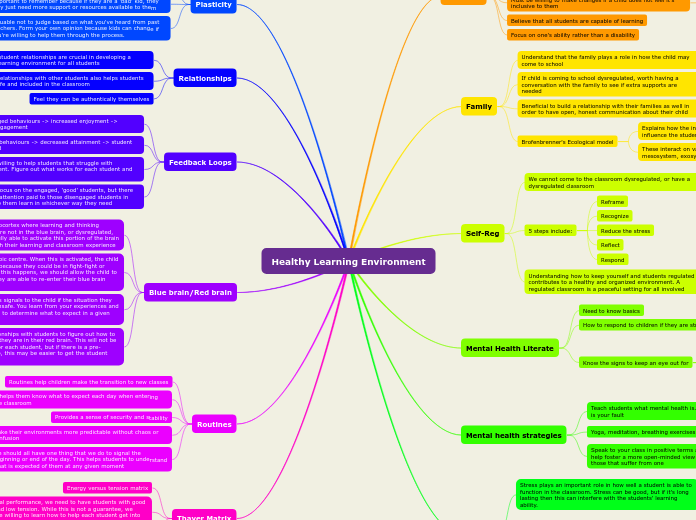Healthy Learning Environment
Inclusive
To all students
Regardless of background (SES, race, class, etc.)
Environment that all students feel safe
Must be willing to make changes if a child does not feel it's inclusive to them
Can ask students what they are or are not comfortable with
Believe that all students are capable of learning
Focus on one's ability rather than a disability
Family
Understand that the family plays a role in how the child may come to school
If child is coming to school dysregulated, worth having a conversation with the family to see if extra supports are needed
Beneficial to build a relationship with their families as well in order to have open, honest communication about their child
Brofenbrenner's Ecological model
Explains how the individual is part of larger systems that influence the student's life and overall development
These interact on various levels including: microsystem, mesosystem, exosystem, macrosystem, and chronosystem
Self-Reg
We cannot come to the classroom dysregulated, or have a dysregulated classroom
5 steps include:
Reframe
Recognize
Reduce the stress
Reflect
Respond
Understanding how to keep yourself and students regulated contributes to a healthy and organized environment. A regulated classroom is a peaceful setting for all involved
Mental Health Literate
Need to know basics
How to respond to children if they are struggling
Know the signs to keep an eye out for
Ability in the classroom
Changes in mood
Frequency
Duration
Mental health strategies
Teach students what mental health is. It's not something that is your fault
Yoga, meditation, breathing exercises
Having these coping mechanisms from a young age can help build resiliency for children when they are faced with adversity
Speak to your class in positive terms about mental health to help foster a more open-minded view of mental illness and those that suffer from one
Stress
Stress plays an important role in how well a student is able to function in the classroom. Stress can be good, but if it's long lasting then this can interfere with the students' learning ability.
Stress is energy consuming. If a child is experiencing chronic stress, this can be detrimental to their learning experiences in the classroom and can also have long-term impacts on their overall health
We all need time for relaxation and restoration, or self reg more generally
Students may freeze when told what to do, but this is not compliance. If this happens, the students needs to come down from this state in order to re-enter the classroom and be successful
Need to think about why the stress is happening for the student, rather than focusing on the behaviour at the surface.
Plasticity
Children demonstrate high levels of plasticity when they are younger. This means that they can adapt to adversity quickly and mold to their environment.
Important to remember because if they are a 'bad' kid, they may just need more support or resources available to them
Valuable not to judge based on what you've heard from past teachers. Form your own opinion because kids can change if you're willing to help them through the process.
Focus on what the child can do, not what they can't
Relationships
Teacher/student relationships are crucial in developing a healthy learning environment for all students
Helps foster a positive relationship with learning
Positive relationships with other students also helps students to feel safe and included in the classroom
Feel they can be authentically themselves
Feedback Loops
Highly engaged behaviours -> increased enjoyment -> increased engagement
Disengaged behaviours -> decreased attainment -> student less engaged
Need to be willing to help students that struggle with disengagement. Figure out what works for each student and be patient
It's easy to focus on the engaged, 'good' students, but there needs to be attention paid to those disengaged students in order to help them learn in whichever way they need
Blue brain/Red brain
Blue brain is the neocortex where learning and thinking occurs. If children are not in the blue brain, or dysregulated, then they are not fully able to activate this portion of the brain which interferes with their learning and classroom experience
Red brain is the limbic centre. When this is activated, the child is not able to learn because they could be in fight-fight or freeze mode. When this happens, we should allow the child to de-escalate until they are able to re-enter their blue brain state.
The amygdala sends signals to the child if the situation they are in are safe or unsafe. You learn from your experiences and use this information to determine what to expect in a given scenario
Need to build relationships with students to figure out how to help children when they are in their red brain. This will not be the same method for each student, but if there is a pre-existing relationship, this may be easier to get the student regulated again.
Routines
Routines help children make the transition to new classes
It helps them know what to expect each day when entering the classroom
Provides a sense of security and stability
Make their environments more predictable without chaos or confusion
We should all have one thing that we do to signal the beginning or end of the day. This helps students to understand what is expected of them at any given moment
For example, start the day with a song and end the day with discussing something they've learned
Thayer Matrix
Energy versus tension matrix
For optimal performance, we need to have students with good energy and low tension. While this is not a guarantee, we need to be willing to learn how to help each student get into that ideal spot on the matrix should they become dysregulated
Low energy and high tension is precarious. When this happens we need to restore students energy
If a child continuously comes to class exhausted, we need to investigate why that may be the case. Allow them to sleep if this is what the child requires to boost their energy
